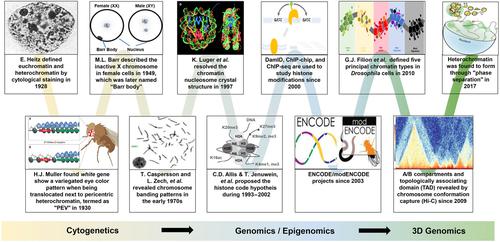当前位置:
X-MOL 学术
›
Ann. N. Y. Acad. Sci.
›
论文详情
Our official English website, www.x-mol.net, welcomes your
feedback! (Note: you will need to create a separate account there.)
Establishment and evolution of heterochromatin
Annals of the New York Academy of Sciences ( IF 4.1 ) Pub Date : 2020-02-04 , DOI: 10.1111/nyas.14303 Jing Liu 1, 2 , Mujahid Ali 2 , Qi Zhou 1, 2, 3
Annals of the New York Academy of Sciences ( IF 4.1 ) Pub Date : 2020-02-04 , DOI: 10.1111/nyas.14303 Jing Liu 1, 2 , Mujahid Ali 2 , Qi Zhou 1, 2, 3
Affiliation

|
The eukaryotic genome is packaged into transcriptionally active euchromatin and silent heterochromatin, with most studies focused on the former encompassing the majority of protein‐coding genes. The recent development of various sequencing techniques has refined this classic dichromatic partition and has better illuminated the composition, establishment, and evolution of this genomic and epigenomic “dark matter” in the context of topologically associated domains and phase‐separated droplets. Heterochromatin includes genomic regions that can be densely stained by chemical dyes, which have been shown to be enriched for repetitive elements and epigenetic marks, including H3K9me2/3 and H3K27me3. Heterochromatin is usually replicated late, concentrated at the nuclear periphery or around nucleoli, and usually lacks highly expressed genes; and now it is considered to be as neither genetically inert nor developmentally static. Heterochromatin guards genome integrity against transposon activities and exerts important regulatory functions by targeting beyond its contained genes. Both its nucleotide sequences and regulatory proteins exhibit rapid coevolution between species. In addition, there are dynamic transitions between euchromatin and heterochromatin during developmental and evolutionary processes. We summarize here the ever‐changing characteristics of heterochromatin and propose models and principles for the evolutionary transitions of heterochromatin that have been mainly learned from studies of Drosophila and yeast. Finally, we highlight the role of sex chromosomes in studying heterochromatin evolution.
中文翻译:

异染色质的建立和进化
真核基因组被包装成转录活性常染色质和沉默异染色质,大多数研究集中在前者,涵盖了大多数蛋白质编码基因。最近各种测序技术的发展完善了这种经典的二色分区,并更好地阐明了在拓扑相关域和相分离液滴的背景下这种基因组和表观基因组“暗物质”的组成、建立和进化。异染色质包括可以被化学染料密集染色的基因组区域,这些区域已被证明富含重复元件和表观遗传标记,包括 H3K9me2/3 和 H3K27me3。异染色质通常复制较晚,集中在核外围或核仁周围,通常缺乏高表达的基因;现在它被认为既不是遗传惰性的,也不是发育静态的。异染色质可保护基因组完整性免受转座子活动的影响,并通过靶向其所包含的基因之外发挥重要的调节功能。它的核苷酸序列和调节蛋白都表现出物种之间的快速共同进化。此外,在发育和进化过程中,常染色质和异染色质之间存在动态转变。我们在这里总结了异染色质不断变化的特征,并提出了主要从果蝇和酵母研究中学到的异染色质进化转变的模型和原理。最后,我们强调性染色体在研究异染色质进化中的作用。
更新日期:2020-02-04
中文翻译:

异染色质的建立和进化
真核基因组被包装成转录活性常染色质和沉默异染色质,大多数研究集中在前者,涵盖了大多数蛋白质编码基因。最近各种测序技术的发展完善了这种经典的二色分区,并更好地阐明了在拓扑相关域和相分离液滴的背景下这种基因组和表观基因组“暗物质”的组成、建立和进化。异染色质包括可以被化学染料密集染色的基因组区域,这些区域已被证明富含重复元件和表观遗传标记,包括 H3K9me2/3 和 H3K27me3。异染色质通常复制较晚,集中在核外围或核仁周围,通常缺乏高表达的基因;现在它被认为既不是遗传惰性的,也不是发育静态的。异染色质可保护基因组完整性免受转座子活动的影响,并通过靶向其所包含的基因之外发挥重要的调节功能。它的核苷酸序列和调节蛋白都表现出物种之间的快速共同进化。此外,在发育和进化过程中,常染色质和异染色质之间存在动态转变。我们在这里总结了异染色质不断变化的特征,并提出了主要从果蝇和酵母研究中学到的异染色质进化转变的模型和原理。最后,我们强调性染色体在研究异染色质进化中的作用。











































 京公网安备 11010802027423号
京公网安备 11010802027423号